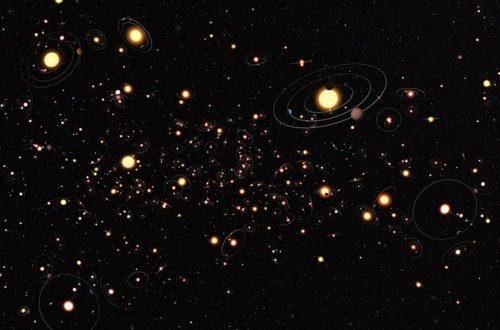
Not long ago, astronomers counted the number of "exoplanets" detected outside our own solar system in the teens, then in the hundreds. Today the tally stands at just over 700.
But the new study, published in Nature, provides evidence that there are more planets than stars in our own stellar neighbourhood.
"We used to think that Earth might be unique in our galaxy," said Daniel Kubas, a professor at the Institute of Astrophysics in Paris, and co-leader of the study.
"Now it seems that there are literally billions of planets with masses similar to Earth orbiting stars in the Milky Way."
Two methods have dominated the hunt over the past two decades for exoplanets too distant and feint to perceive directly.
One measures the effect of a planet's gravitational pull on its host star, while the other detects a slight dimming of the star as the orbiting planet passes in front of it.
Both of these techniques are better at finding planets that are massive in size, close to their stars, or both, leaving large "blind spots".
An international team of astronomers led by Kubas and colleague Arnaud Cassan used a different method called gravitational microlensing, which looks at how the combined gravitational fields of a host star and the planet itself act like a lens, magnifying the light of another star in the background.
If the star that acts as a lens has a planet, the orbiting sphere will appear to slightly brighten the background star.
One advantage of microlensing compared to other methods is that it can detect smaller planets closer in size to our own, and further from their hot-burning stars.
The survey picked up on planets between 75 million and 1.5 billion kilometres from their stars -- a range equivalent in the Solar System to Venus at one end and Saturn at the other -- and with masses at least five times greater than Earth.
Over six years, the team surveyed millions of stars with a round-the-world network of telescopes located in the southern hemisphere, from Australia to South Africa to Chile.
Besides finding three new exoplanets themselves -- no minor feat -- they calculated that there are, on average, 1.6 planets in the Milky Way for every star, Cassan told AFP.
Whether this may be true in other galaxies is unknown.
"Remarkably, these data show that planets are more common than stars in our galaxy -- they are the rule rather than the exception," Cassan said. "We also found lighter planets ... would be more common than heavier ones."
One in six of the stars studied was calculated to host a planet similar in mass to Jupiter, half had planets closer in mass to Neptune, and nearly two-thirds had so-called super-Earths up to 10 times the mass of the rock we call home.
Another study published the same day in Nature, meanwhile, showed that planets simultaneously orbiting two stars -- known as circumbinary planet systems -- are also far more common than once supposed.
There are probably millions of planets with two suns, concluded the study, led by William Welsh of San Diego State University in California.
<한글기사>
모든 별엔 행성이 있다
우리은하에만 행성 수천억개
우리은하의 모든 별은 주위에 최소한 한 개, 평균 1.6개의 행 성을 거느리고 있다는 획기적인 연구가 발표됐다고 BBC 뉴스와 MSNBC뉴스 등이 12일 보도했다.
전세계의 20여 연구 기관에서 참여한 유럽남부천문대(ESO) 과학자들은 지난 6년 동안 우리은하의 별 수백만 개를 대상으로 중력 마이크로렌징 기법을 사용, 행성들 이 나타나는 빈도를 조사한 결과 행성을 거느린 별이 예외적인 것이 아니라 그 반대 로 모든 별 주위에 행성들이 돌고 있다는 보편적인 법칙을 확인했다고 밝혔다.
이들의 계산에 따르면 우리은하에 존재하는 행성의 수만 해도 1천600만개나 된 다.
이 연구는 미국 천문학회 연례회의와 12일자 네이처지에 발표됐다.
지난 16년간 과학자들은 700여개의 외부 행성을 발견했지만 이는 대부분 행성의 중력이 중심별에 미치는 영향을 계산하는 시선속도 기법이나 중심별 앞으로 행성이 지나갈 때 줄어드는 별빛을 계산하는 천이(遷移)관찰 방식으로 이뤄졌다.
이에 비해 작은 우주망원경들로 이루어진 네트워크를 사용하는 중력 마이크로렌 징 기법은 훨씬 광범위한 질량의 행성들과 아주 먼 거리에서 도는 행성들까지도 포 착할 수 있는 매우 정확한 방식이다.
연구진이 실제로 중력 마이크로렌징 기법으로 발견한 행성의 수는 40개에 불과 하지만 이들은 통계학적 방법을 이용, 우리은하의 별들이 갖는 행성의 규모와 수를 계산했다.
계산 결과 전체 별의 17%는 목성급(목성 질량의 0.3~10배) 행성을, 52%는 해왕 성급(지구 질량의 10~30배) 행성을, 62%는 슈퍼지구급(지구 질량의 5~10배) 행성을 거느리고 있는 것으로 나타났다.
연구진은 이런 계산은 수많은 불확실한 요소들로 둘러싸여 있긴 하지만 지금까 지 나온 어떤 계산보다도 실제에 가까운 것이라고 강조했다.
이들은 "지금까지 우리는 지구가 우리은하에서도 유일무이한 존재라고 생각해 왔지만 알고 보면 지구와 비슷한 질량을 가진 행성은 수십억개나 된다"면서 앞으로 생명체가 사는 행성을 찾을 가능성도 점점 커지고 있다고 지적했다. (연합뉴스)


![[Exclusive] Korean military set to ban iPhones over 'security' concerns](http://res.heraldm.com/phpwas/restmb_idxmake.php?idx=644&simg=/content/image/2024/04/23/20240423050599_0.jpg&u=20240423183955)

![[Graphic News] 77% of young Koreans still financially dependent](http://res.heraldm.com/phpwas/restmb_idxmake.php?idx=644&simg=/content/image/2024/04/22/20240422050762_0.gif&u=)



![[Pressure points] Leggings in public: Fashion statement or social faux pas?](http://res.heraldm.com/phpwas/restmb_idxmake.php?idx=644&simg=/content/image/2024/04/23/20240423050669_0.jpg&u=)









